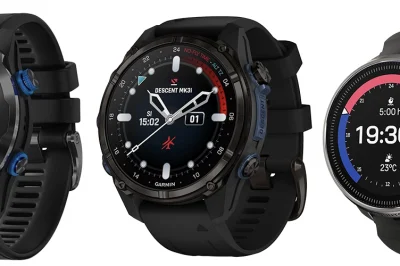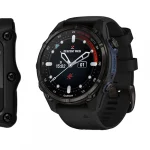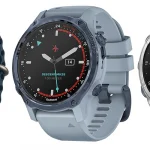The Perfect Fit: Compact Designed Computers

Table of Contents
- The Perfect Fit: Compact Designed Computers
- Customizability: Tailor Your Tech
- User-Friendly Interfaces: Simplifying the Dive
- Multi-mode Marvels: Dive with Flexibility
- Staying Safe: Advanced Safety Features
- Women-Centric Health Tracking: More Than Just Diving
- Durability That Withstands the Elements
- Beyond Water: Dual-Use Features for Lifestyle Divers
Introduction
In celebration of PADI Women’s Dive Day, this special article explores the diving computer features that female divers consistently value. With insights into top models and must-have functionalities, this guide helps divers make informed decisions when purchasing a diving computer.
The Perfect Fit: Compact Designed Computers
When customising diving computers for women, key considerations include comfort, aesthetics, and functionality based on specific needs. Here’s a structured approach to tailoring a dive computer:
Design and Fit
- Compact and lightweight construction: Prioritise smaller devices (e.g., Shearwater Teric, Suunto D5) suitable for smaller wrists, reducing bulk during dives.
- Wrist fit: Ensure the device offers adjustable or interchangeable straps to accommodate different wrist sizes and comfort preferences.
- Stylish appearance: Look for sleek designs with optional watch-style interfaces, such as the Garmin MK2S, which can double as everyday smartwatches.
Customisation Features
- Replaceable straps: Brands like SCUBAPRO and Aqualung provide modular straps available in various materials (nylon, silicone, leather) and colours to match personal style.
- Display layouts: Select computers with customisable screens (e.g., Suunto D5) that allow prioritisation of depth, time, or air data as needed during dives.
Functionality and Versatility
- Multi-sport compatibility: Devices such as the Garmin MK2S include features for fitness tracking and heart rate monitoring, making them suitable for various land-based activities.
- Dive modes: Ensure the computer supports recreational, technical, and freediving modes to accommodate skill progression and versatility in diving experiences.
Durability and Usability
- Rugged build: Look for computers with scratch-resistant screens and robust waterproof casings (e.g., Aqualung’s instruments) for durability in challenging environments.
- Intuitive interface: Seek devices equipped with user-friendly navigation, whether touch-sensitive or button-operated (like the Suunto D5), for easily accessible settings underwater.
Why It Matters
A well-curated dive computer enhances both safety and enjoyment by aligning with the user’s body size, aesthetic preferences, and diving style. For instance, a diver who prioritises fashion might choose a Garmin MK2S with a leather strap for post-dive wear, while a technical diver may opt for the Shearwater Teric’s advanced gas management features. Additionally, custom bundles available from retailers allow divers to combine transmitters, straps, and accessories into a tailored setup.
Customizability: Tailor Your Tech
User-Friendly Interfaces: Simplifying the Dive
User-friendly interfaces in diving computers are crucial for enhancing the diving experience, especially for women divers. These intuitive settings are designed to streamline operations, ensuring that divers can focus on their underwater environment rather than grappling with complex technology. Here, we explore key features that contribute to a simpler, more accessible diving experience.
Key Interface Features
- Intuitive Menus and Logical Layouts: The Garmin Descent G1 stands out with its colour display and a special “Big Numbers Mode,” which enlarges important data for easy viewing. It operates with a two-button system, allowing smooth navigation through a series of logical menus, making it user-friendly even for advanced features.
- Readable Displays: A computer like the Suunto Zoop Novo is designed with a big, bright backlit display, optimised for visibility underwater. Its simple interface is especially advantageous for beginners who need quick access to vital information at a glance.
- Compact and Adjustable Design: Lightweight models such as the Suunto D4i Novo offer a menu-driven interface with essential data prioritised. Its customisable straps enhance the fit for smaller wrists, making it a comfortable choice for women divers.
Top Models for Women Divers
- Garmin G1: Known for its streamlined operation through two buttons and a vivid colour screen, this model is incredibly user-friendly.
- Suunto D4i Novo: Features a mineral glass face for improved visibility and a customisable, menu-based interface.
- Suunto Zoop Novo: Offers a simplified interface with large, backlit displays and multiple dive modes.
Overall, these diving computers not only prioritise ergonomics and ease of use but also promote a more enjoyable diving experience by minimising distractions. A clear, user-friendly interface is essential for any diver looking to navigate their underwater world with confidence.
User-Friendly Interfaces: Simplifying the Dive
Multi-mode dive computers are revolutionising the underwater experience by providing divers with the flexibility to switch between various modes depending on their diving style, whether recreational, technical, or freediving. These advanced devices cater to a broad spectrum of diving activities, each with specific requirements and preferences.
Core Modes in Modern Dive Computers
- Air/Nitrox: These basic modes are designed for single-gas dives and include built-in decompression algorithms, accommodating the needs of recreational divers.
- Trimix/Nitrox (3 Gas): Available in higher-end models like the Shearwater Perdix 2, designed for technical divers who require the capability to switch between multiple gas types.
- Gauge Mode: Functions primarily as a bottom timer, making it an excellent choice for freediving, as it does not trigger any decompression alarms.
- OC Tec (Trimix): Supports complex decompression strategies for open-circuit diving and multi-gas jumps.
- CC/BO (Closed Circuit): Designed specifically for rebreather diving, allowing users to efficiently manage gas mixes and decompression profiles.
- Air Integration: A critical feature for technical divers, allowing for the tracking of gas levels across multiple tanks simultaneously.
Most recreational dive computers may not explicitly incorporate freediving modes; however, gauge mode allows divers to manually monitor their depth and time, making it suitable for freediving applications. Advanced features like vibration alerts can enhance safety during ascents.
Future Advancements
The diving technology landscape is rapidly evolving, and several recent innovations are shaping the future of multi-mode dive computers:
- Underwater Messaging: The integration of messaging capabilities enables divers to send and receive preset messages, significantly improving communication underwater.
- 3D Dive Tracking: Future models may incorporate GPS and accelerometers to allow divers to visualise their dive routes in three dimensions after their dives.
- Integrated Gas Analysers: Built-in oxygen analysers will simplify nitrox blending and enhance safety for technical divers.
- Enhanced Accessibility: Features like big numbers mode and haptic feedback alerts will ensure that information is easily interpretable for all divers.
With ongoing advancements, future dive computers are likely to integrate real-time gas tracking capabilities and AI-driven decompression models, further enhancing the diving experience.
Model Recommendations
- Shearwater Perdix 2: This model is ideal for technical divers due to its air integration and multi-transmitter support.
- Garmin Mk3i: A great choice for those needing underwater messaging and sophisticated sensor technology.
- Suunto DSX: Offers built-in gas analysis which streamlines nitrox diving operations.
The future looks bright for multi-mode dive computers, with advancements promising to enhance versatility and safety for divers of all levels.
Multi-mode Marvels: Dive with Flexibility
Advanced Safety Features in Diving Computers
Modern diving computers are equipped with sophisticated algorithms designed to enhance diver safety during underwater excursions. The ZH-L 16 Gradient Factor Algorithm, utilised in advanced devices, adjusts safety measures based on dive conditions while prioritising safety for technical divers. These systems continuously monitor tissue gas absorption, thereby preventing nitrogen build-up during ascents.
- Tissue compartment modelling: These algorithms track gas loading across 16 or more hypothetical compartments, enabling precise decompression calculations.
- Gradient factor adjustments: This feature balances the need for rapid off-gassing against residual gas burdens within the tissues.
- Multi-stage safety stops: The algorithm guides divers to perform required decompression pauses at specific depths, addressing potential hazards of rapid ascents.
Critical Safety Features
Diving computers also encompass a range of critical safety features that further ensure a safe diving experience:
- Real-Time NDL Tracking: They dynamically calculate No-Decompression Limits (NDLs), adjusting for changes in depth, gas consumption, and previous dives to avoid exceeding safe limits during multilevel profiles.
- Ascent Rate Monitoring: Sensors alert divers if they ascend too quickly, minimising the risk of decompression sickness (DCS). Many models allow for customisable ascent rate warnings.
- Wireless Air Integration: By connecting wirelessly to tank pressure transmitters, these devices provide calculations for remaining bottom time based on breathing rates, depth, and tank volume, ensuring accurate data.
- Multi-Gas Support: Technical diving computers are specially designed to manage gas switches, but errors related to incorrect gas percentages can lead to dangerous decompression decisions.
Common Mistakes in Algorithm Use
- Ignoring safety stop alerts: Neglecting mandatory stops can greatly increase the risk of DCS.
- Incorrect gas labelling: Mislabelling gases can result in dangerously inaccurate decompression profiles.
- Using incorrect dive modes: Diving in recreational mode during technical dives can lead to inadequate safety precautions.
- Overriding computer advice: Bypassing the computer’s calculated times and ascent protocols can result in premature ascents, heightening the risk of DCS.
Advanced dive computers hold a significant advantage over static manual tables, particularly in their ability to adapt to real-time conditions. They can handle:
- Multilevel dives: Adjusting calculations for varying depths, unlike tables that assume single-depth profiles.
- Repetitive dives: Accounting for residual nitrogen from earlier dives, thus mitigating cumulative overpressure risks.
This combination of dynamic algorithms and user-controlled features helps ensure safety even in complex diving scenarios.
Dive Computers
- Diving Computers for Female Divers
- Wreck Diving Computers
- Beginner Diving Computers
- Low-Light Diving Computers
- Technical Diving Computers
- Freediving Computers
- Underwater Photography Diving Computers
- Cold-Water Diving Computers
- Travel-Friendly Diving Computers
- Multi-sport Diving Computers
- Budget-Friendly Diving Computers
- Advanced Recreational Diving Computers
- Smartwatch-Compatible Diving Computers
- Child-Friendly Diving Computers
- Military or Professional Diving Computers
Staying Safe: Advanced Safety Features
Integrating Women’s Health Tracking Features in Dive Computers
Recent advancements in dive computer technology are increasingly addressing the unique health tracking needs of female divers, notably through features like menstrual cycle tracking. This addition is significant, as it empowers women by allowing them to monitor physiological changes that can affect diving performance and health safety.
One of the standout models is the Garmin Descent Mk2S, marketed as the first dive computer tailored specifically for women. This device integrates menstrual and pregnancy tracking directly into its interface. Users can log their cycles, symptoms, and receive predictions for upcoming periods, which helps in planning dives safely. Furthermore, it tracks essential health metrics such as all-day respiration and sleep stages, enhancing overall wellness monitoring.
Another notable option is the Suunto Ocean. Although it does not feature menstrual tracking directly on the device, it connects with an app that allows users to input their data. This functionality aids in predicting periods, which is particularly useful for divers who need to be aware of their physiological state while diving.
Additionally, the Garmin Descent G1 Solar supports menstrual cycle tracking through the Garmin Connect app, enabling users to gain insights into how their cycles may influence their activities and health during dives. This is a vital feature for women looking to maintain a strong connection between health and diving performance.
The incorporation of these features not only augments diving safety measures but also promotes informed diving choices based on individual health metrics, ensuring a more tailored diving experience for women.
Women-Centric Health Tracking: More Than Just Diving
Top Picks for Durable Dive Computers for Women
When selecting a reliable diving computer, women divers should prioritise build quality and durability, especially when navigating harsh underwater environments. Here are some top picks that offer ruggedness alongside advanced features:
- Garmin Descent MK2S/MK2i
- Compact and lightweight: With a 43 mm case diameter, it’s ideal for smaller wrists, ensuring comfort underwater.
- Advanced features: Tec-capable modes, multisport tracking, and an impressive 200-dive battery life make it a versatile choice for diverse diving experiences.
- Reliability: Built to withstand technical diving conditions, this model provides robust performance even in challenging environments.
- Suunto D5/DX
- Rugged construction: As a trusted brand known for durability, these models include advanced features like customisable displays for user preference.
- Versatility: They are compatible with various activities including diving and freediving, boasting long-lasting battery life — up to 200 hours for the D5.
- Shearwater Teric/Perdix 2 Ti
- Titanium build: Known for its lightweight yet highly durable properties, this model is perfect for technical diving.
- User-friendly design: It features customisable screens and intuitive navigation, ensuring easy access to critical data.
Key Durability Features
When evaluating dive computers for durability, consider the following factors:
- Water resistance: All mentioned models exceed recreational diving depths, often rated for 200-300 meters or more, ensuring reliable performance underwater.
- Material resilience: Using materials such as titanium (notably in the Perdix 2 Ti) and elastomer (in the Suunto DX) enhances longevity against saltwater and extreme temperatures.
- Reliability: The tech capabilities in Garmin and Shearwater models minimise computational errors during deep or repetitive dives, crucial for safety.
Additional Considerations
Other important features that contribute to a dive computer’s usability include:
- Customisable straps: Models by Suunto and Shearwater offer interchangeable bands for a secure fit, ensuring comfort during rough dives.
- Battery longevity: Rechargeable options available in both Suunto and Garmin models eliminate the need for frequent battery changes, critical for extended diving trips.
For those engaged in technical diving, the Shearwater Perdix 2 Ti or Garmin MK2i are excellent options. For multifaceted use including recreational diving, the Suunto D5 strikes a balance between style and ruggedness.
Durability That Withstands the Elements
Modern dive computers now offer dual-use features that cater to both diving and everyday lifestyle needs. Here are the key capabilities and models supporting these functionalities:
Biometric Monitoring for Dive and Fitness
Certain computers integrate health tracking sensors that serve both diving and fitness purposes:
- Heart rate monitoring during dives to assess physical stress and step tracking for land-based activities.
- Breathing rate tracking that doubles as a fitness metric for workouts.
Models: SCUBAPRO computers emphasise these biometric features, making them suitable for active divers who also prioritise fitness.
Bluetooth Connectivity and App Integration
Wireless connectivity enhances pre-/post-dive planning and daily device management:
- Firmware updates and log transfers via companion apps (e.g., Divesoft App for Freedom+).
- Remote adjustments to settings like Nitrox mixes or algorithms through a smartphone app (Oceanic VEO 4.0).
Models:
- Freedom+ (Divesoft): Enables Bluetooth-driven firmware upgrades and dive log management.
- VEO 4.0 (Oceanic): Syncs with the DiverLog+ App for dive planning, data sharing, and profile analysis.
Wearable Design for Daily Use
Slim profiles and intuitive interfaces allow these computers to double as everyday watches:
- 20% slimmer design (VEO 4.0) for comfort during hikes or casual outings.
- Larger digit displays for clear readability both underwater and on land.
Post-Dive Data Sharing
Integrating dive logs with social and multimedia tools enhances lifestyle engagement:
- Photo/video integration (VEO 4.0) for sharing dive highlights on social platforms.
- Dive archive filtering by location, depth, or type for personal tracking or storytelling.
Upgradeable Systems for Versatility
Some computers support software upgrades to expand functionality as diving skills evolve:
- Trimix to CCR transitions (Freedom+): A firmware update via Bluetooth unlocks advanced closed-circuit diving capabilities.
- Algorithm switching (VEO 4.0): Users can toggle between DSAT and Pelagic Z+ decompression models for varying dive conditions.
Entertainment and Gamification
A few models include casual gaming features, adding recreational value:
- Freedom+ (Divesoft): Built-in games for downtime entertainment.
Comparison of Dual-Use Features
| Feature | Freedom+ (Divesoft) | VEO 4.0 (Oceanic) | SCUBAPRO Models |
|---|---|---|---|
| Bluetooth/App | Yes | Yes | Limited |
| Biometrics | Limited | No | Yes |
| Wearable Design | Durable | Slim & Comfy | Ergonomic |
| Algorithm Flexibility | Firmware upgrades | Dual Algorithm™ | Limited |
| Games | Yes | No | No |
These integrations make dive computers practical lifestyle tools, blending technical performance with everyday usability.
Beyond Water: Dual-Use Features for Lifestyle Divers
Key Features of Dive Computers for Female Divers
Dive computers tailored for women prioritise slim profiles and lightweight materials to suit smaller wrists, reducing bulk during dives. The Garmin Descent Mk2S, designed specifically for female divers, is the smallest watch-style model by Garmin, ensuring comfort during long dives. This model exemplifies the evolution of dive technology designed with a female demographic in mind.
Health and Fitness Integration
The Descent Mk2S includes women’s health tracking, such as menstrual cycle monitoring and pregnancy tracking, alongside sleep and breath tracking. This feature merges diving functionality with holistic wellness tracking for active lifestyles, providing essential insights for female divers.
Customisable Aesthetics and Adjustability
- Interchangeable straps allow divers to personalise styles, with options in silicone bands available in light gold, carbon grey, or mineral blue.
- Customisable display layouts let users prioritise dive data (depth, time, gas mixes) alongside non-diving metrics (heart rate, notifications).
Advanced Dive Modes and Tech
- Multi-gas compatibility (nitrox, trimix, CCR) supports both recreational and technical diving.
- Surface GPS in models like the Garmin Descent Mk1 enables tracking of entry and exit points with full-colour mapping.
- Wireless air integration and altitude adjustment enhance safety for open-water and altitude diving scenarios.
| Feature | Garmin Descent Mk2S | Suunto D5 |
|---|---|---|
| Wrist Size | Compact, small wrist | Watch-style |
| Health Tracking | Menstrual cycle, sleep | N/A |
| Battery Life | 7 days | Rechargeable (USB) |
| Dive Modes | Nitrox, trimix, CCR | Air, mixed gas, CCR |
Durability and Functionality
- Waterproof designs withstand harsh environments, from tropical dives to technical challenges.
- Smart notifications (calls, texts, calendar alerts) and music storage add utility beyond diving.
These features address both safety and personalisation, catering to female divers’ needs for comfort, style, and versatility.
Sources
- DiveCatalog – Dive Computer Package Quote
- SCUBAPRO – Computers
- ScubaBoard – Wrist Computers for Women
- Aqualung – Computer Gauges
- Florida Scuba Diving – Best Diving Computers for Female Divers
- Girls That Scuba – Best Scuba Diving Computers
- Scuba Diving – Best New Dive Computers 2023 Reviewed
- JoeScuba – Shearwater Dive Computers Model Comparison





